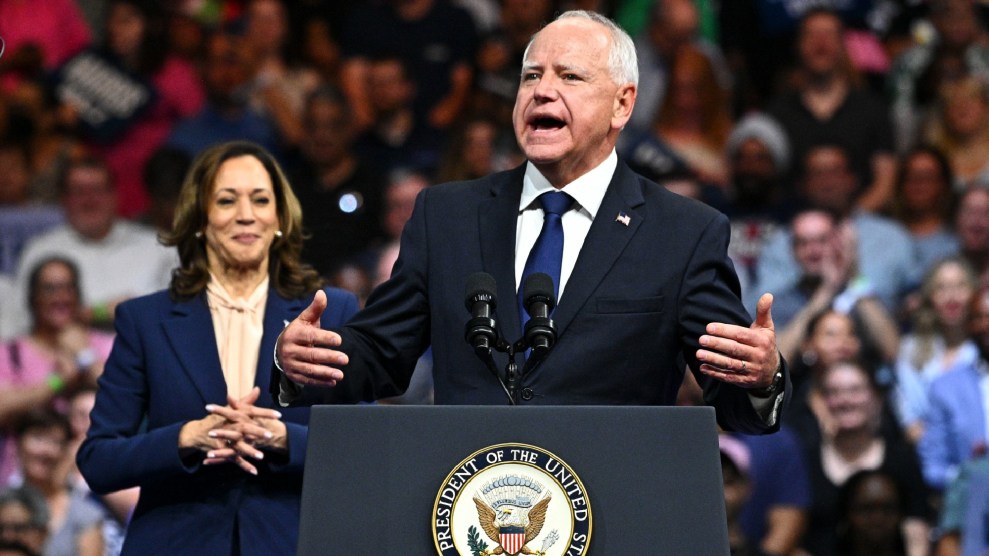
Tim Walz, vice presidential hopeful, speaks at a campaign rally in Philadelphia. Ricky Fitchett/Zuma Press Wire
This piece was published originally by Capital & Main.
Minnesota Gov. Tim Walz, Kamala Harris’ running mate, has quietly become one of the country’s most aggressive advocates for taking action on climate change. Under his leadership, Minnesota has adopted some of the most ambitious climate policies in the nation—including a law he signed in 2023 that requires the state to generate all of its electricity from renewable sources by 2040. During that legislative session, Walz and state lawmakers pushed through at least 40 other climate-related initiatives.
“The idea [is] that we can create a clean energy future where we can protect our water, protect our land, and do that in a manner that grows the economy in Minnesota,” Walz said in announcing those initiatives.
Under the clean-electricity law, Minnesota is on track to transition to clean-energy sources even faster than California, which is often seen as America’s trailblazer when it comes to climate action. It’s also more ambitious than a requirement that President Biden tried to include in his landmark Inflation Reduction Act.
In 2022, Walz announced a plan to increase sales of EVs to 20 percent of all vehicles, and to cut greenhouse gas emissions by half by 2030.
Walz’s selection by Harris was hailed by leading environmental groups. “In his time serving in Congress and as Governor, he has worked to protect clean air and water, grow our clean energy economy, and see to it that we do all we can to avoid the very worst of the climate crisis,” said Sierra Club Executive Director Ben Jealous in a statement.
“Governor Tim Walz’s unwavering commitment to bold action led to the biggest thing our state has ever done to address the climate crisis, and we have been proud to partner with him on many initiatives to reduce dangerous pollution and protect our Great Outdoors,” said Conservation Minnesota Voter Center Executive Director Paul Austin.
Walz’s evolution on the issue grew with the impact of climate change he saw in his home state. He was a school teacher and football coach and served in the Army National Guard before he was elected to Congress in 2006, serving six terms and supporting environmental legislation but not known as a climate champion.
In his first run for Congress in 2006, he didn’t mention global warming on his campaign website, unlike other progressive candidates, and talked about “energy independence.” But in recent years the impact of climate change on the state has been intense—such as wildfire smoke from Canada polluting the air over Minneapolis, extreme drought prompting farmers to cull their herds and experiencing crop failure, and torrential rains causing flooding.
And Walz has become more of a climate advocate—establishing a climate change subcabinet within his administration in 2019 and announcing a plan in 2022 to increase sales of electric vehicles to 20 percent, and reduce greenhouse gas emissions by 50 percent by 2030.
In his latest action, last month, he welcomed a $200 million grant from the US Environmental Protection Agency to reduce climate pollution in the state with new equipment for farmers, food waste prevention, peatland restoration, and electric vehicles.
Walz has been hailed for his skills at communicating the need for climate policies and renewable energy initiatives. “The surest way to get people to buy in is to create a job that pays well in their community,” he told TIME magazine recently. “All of us are going to have to be better about our smart politics, about bringing people in.”
Sometimes, that focus on jobs has led him to work with polluting industries, raising concerns among environmentalists. Last month, a coalition of 16 Minnesota environmental groups called out state agencies for lax regulation of industry and accusing the agencies of “polluter capture”—when industry has sway over regulatory decision-making—citing examples of the approval of a controversial oil pipeline in northern Minnesota and the failure to take action against a polluting foundry in Minneapolis.
In a written statement to Sahan Journal, the Walz administration said: “The state has a strong record of holding polluters accountable and working with the community and the legislature to ensure health and our natural resources are protected.”















